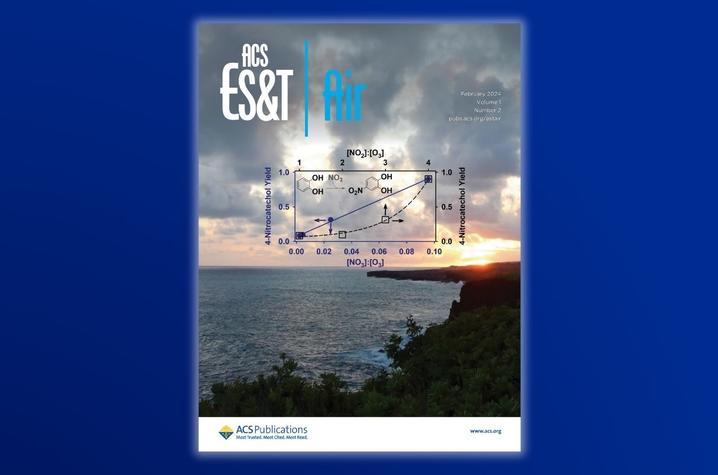Chemists study how changes in atmospheric composition can impact air pollution

Chemists at the University of Kentucky are researching how changes in the atmosphere’s composition may play a role in forming air pollution.
The study was recently featured on the cover of the journal American Chemical Society (ACS) Environmental Science & Technology (ES&T) Air, which focuses on investigations of air chemistry and physics, air pollution and climate change that impact human and ecosystem health.
Marcelo Guzman, Ph.D., associate professor in the Department of Chemistry in the College and Arts and Sciences and lead chemist in the Environmental Chemistry Laboratory, was the principal investigator of the study funded by the National Science Foundation.
Guzman and graduate students Sohel Rana and Seth Bradley examined the role of common forms of pollution — vehicle emissions, wildfires, industrial fumes and power plant exhaust — and their release of catechol molecules into the atmosphere.
“Catechol serves as a precursor in the formation of 4-nitrocatechol, a compound found in widespread atmospheric brown carbon,” said Guzman. “Brown carbon absorbs sunlight. Our previous research has explored the importance of understanding the changes in sunlight absorption because it directly affects the atmosphere’s radiation properties.”
Researchers collected samples in the atmosphere over rural regions of Germany, China and the United Kingdom that had high levels of these nitroaromatic compounds.
“Biomass burning, which includes the burning of crop residues, wood, leaves, grasses, agricultural waste and other plant materials, is particularly important for the formation of 4-nitrocatechol,” said Guzman. “This type of pollution could dominate up to 60% of such compounds detected during winter in rural China.”
Guzman’s team is the first to specifically study these interactions at the interface of water and air. In this study, researchers explored how catechol reacts with nitrate radicals — compounds made up of oxygen bonded to nitrogen and an important player in reactions between atmospheric components.
“We used a special reactor that samples so quickly the interface of water microdroplets without the interference of other heterogeneous reactions provided by the wall of the container,” said Guzman. “The atmospheric science community was not considering these unknown reactions in smoke that imply the transfer of electrons and protons between the chemicals as well as the fact that a radical attack can proceed on the surface of water.
"In our experiments, as soon as the microdroplets containing catechol — the aromatic marker of pollution in smoke — are created, they are stricken by a flow of gas with the very short-lived nitrate radical. The interaction of these molecules on the surface of water particles lasts less than a millionth of a second, a time that is long enough to create nitrocatechol, a brown carbon product, which is quickly and unambiguously detected by a state-of-the-art mass spectrometer."
The team also tested the ratios of two important atmospheric gases: Nitrogen dioxide (NO2) and ozone (O3). Their goal was to find out how the ratios of these gases influence the formation of 4-nitrocatechol.
“The results shed light on processes that contribute to pollution from biomass burning and combustion emissions,” said Guzman.
Researchers said their findings also suggest that using appropriate ratios of NO2 to O3 in laboratory experiments is important to accurately study how catechol and other compounds chemically interact with nitrogen.
You can find the full paper “Conversion of Catechol to 4-Nitrocatechol in Aqueous Microdroplets Exposed to O3 and NO2” online here.
Research reported in this publication was supported by the National Science Foundation under Award Numbers 1903744 and 1922694. The opinions, findings, and conclusions or recommendations expressed are those of the author(s) and do not necessarily reflect the views of the National Science Foundation.
Credits
Lindsay Travis (Research Communications)
Image courtesy of ACS Publications
